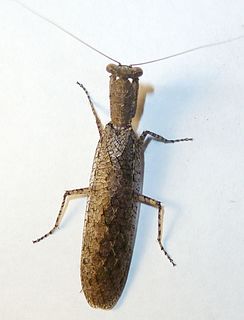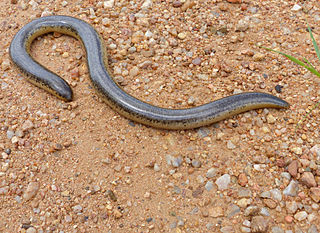Related Research Articles

The cicadas are a superfamily, the Cicadoidea, of insects in the order Hemiptera. They are in the suborder Auchenorrhyncha, along with smaller jumping bugs such as leafhoppers and froghoppers. The superfamily is divided into two families, the Tettigarctidae, with two species in Australia, and the Cicadidae, with more than 3,000 species described from around the world; many species remain undescribed.

Cinnyris is a genus of sunbirds. Its members are sometimes included in Nectarinia. They are generally known as double-collared sunbirds because the fringe of their bib usually includes a band of contrastingly coloured feathers.

The twig snakes, also commonly known as bird snakes or vine snakes, are a genus of rear-fanged venomous snakes in the family Colubridae. The genus is native to Africa. All species in the genus have a slender and elongated profile, a long tail, a narrow head, and a pointed snout. The eye of all species has a horizontal pupil, shaped like a keyhole, which gives twig snakes binocular vision. Twig snakes are greyish-brown with faint light and dark markings. When threatened, they inflate the throat to display bold black markings between the scales. Twig snakes are deadly: the venom is hemotoxic, affecting the blood clotting mechanism and causing uncontrolled bleeding and internal hemorrhaging. Bites by twig snakes have caused death in humans; famous herpetologist Robert Mertens died after being bitten by his pet Savanna vine snake. However, envenomed bites are extremely rare when not handling the snake, as the fangs can't reach the skin except in a few places like the web between the thumb and fingers.
In biology, a species is the basic unit of classification and a taxonomic rank of an organism, as well as a unit of biodiversity. A species is often defined as the largest group of organisms in which any two individuals of the appropriate sexes or mating types can produce fertile offspring, typically by sexual reproduction. Other ways of defining species include their karyotype, DNA sequence, morphology, behaviour or ecological niche. In addition, paleontologists use the concept of the chronospecies since fossil reproduction cannot be examined.

The bark mantises and ground mantises are praying mantids now placed in the family Eremiaphilidae that are native to the Afrotropics. They are generally light brown but more silvery on the wings. The wings are attractively reticulated, and the veins may be mottled dark and pale. The head is wider than the pronotum, which is rounded anteriorly, and doesn't overlap with the rear of the head. The pronotum is depressed, with its sides more or less parallel, and only a weak supra-coxal bulge is present. The anterior tibia are flattened and greatly expanded longitudinally, and the tibial claw does not fit into a pit between the 1st and 2nd external spines of the anterior femora, as in a few mantis groups.
Tarachodes usambaricus is a species of praying mantis in the family Eremiaphilidae.

Gymnosiphon (yellowseed) is a genus of monocotyledonous flowering plants from the yam order. Like most of the other members of the family in which the plant is placed (Burmanniaceae), Gymnosiphon is entirely myco-heterotrophic genus that does not contain chlorophyll and respectively does not perform photosynthesis.
The Usambara double-collared sunbird is a species of bird in the family Nectariniidae. It is a resident breeder in the tropical moist montane forests of southeast Kenya and northeast Tanzania.

Termitotroginae is a monotypic subfamily of the family Scarabaeidae, the scarab beetles. The only genus in the subfamily is Termititrox. A second genus, Aphodiocopris, Arrow, 1920, has been synonymised with Termitotrox. All known members of this subfamily are tiny, blind and flightless, and dwell within the fungal gardens of colonies of species of termite in Africa or tropical Asia.
Afrotridactylus is a genus of pygmy mole crickets, which contains the following species:
The African sandhopper is a species of pygmy mole cricket found throughout Africa south of the Sahara Desert. It prefers sandy or muddy open river banks. It has been recorded from Niokolo-Koba National Park in Senegal.

Crossotini is a tribe of longhorn beetles of the subfamily Lamiinae. It was described by Thomson in 1864.

Idactus is a genus of longhorn beetles of the subfamily Lamiinae.
Baraeomimus usambaricus is a species of beetle in the family Cerambycidae, and the only species in the genus Baraeomimus. It was described by Breuning in 1973.
Idactus usambaricus is a species of beetle in the family Cerambycidae. It was described by Hintz in 1910.

Novius is a genus of ladybird beetles belonging to the family Coccinellidae, and the sole member of the tribe Noviini. The genus as presently defined contains over 70 species, most of which were formerly placed in the genera Rodolia and Anovia, but after decades of debate, both of these genera are now considered to be junior synonyms of Novius.
Gymnosiphon usambaricus is a species in the plant family Burmanniaceae. It is endangered due to habitat loss with an estimated 2500 mature individuals left. It is native to Kenya and Tanzania, and is found in the leaf litter in evergreen forests.

Afrotyphlops is a genus of snakes in the family Typhlopidae.
Sycorax is a genus of moth flies and sand flies in the family Psychodidae. There are at least 40 described species in Sycorax.
The Usambara blotched blind-snake is a species of snake in the Typhlopidae family.
References
- ↑ Biolib.cz - Pseudocorus usambaricus. Retrieved on 8 September 2014.